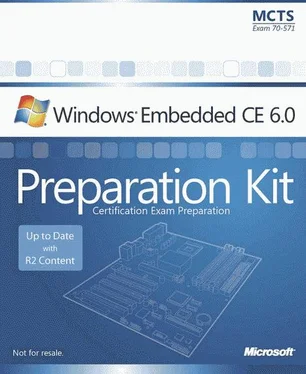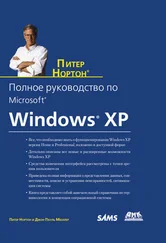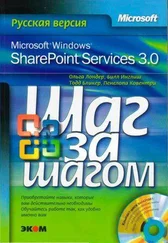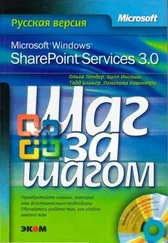Nicolas Besson - Microsoft Windows Embedded CE 6.0 Exam Preparation Kit
Здесь есть возможность читать онлайн «Nicolas Besson - Microsoft Windows Embedded CE 6.0 Exam Preparation Kit» весь текст электронной книги совершенно бесплатно (целиком полную версию без сокращений). В некоторых случаях можно слушать аудио, скачать через торрент в формате fb2 и присутствует краткое содержание. Город: Redmond, Год выпуска: 2008, Издательство: Microsoft, Жанр: Руководства, ОС и Сети, Программы, на английском языке. Описание произведения, (предисловие) а так же отзывы посетителей доступны на портале библиотеки ЛибКат.
- Название:Microsoft Windows Embedded CE 6.0 Exam Preparation Kit
- Автор:
- Издательство:Microsoft
- Жанр:
- Год:2008
- Город:Redmond
- ISBN:нет данных
- Рейтинг книги:5 / 5. Голосов: 1
-
Избранное:Добавить в избранное
- Отзывы:
-
Ваша оценка:
- 100
- 1
- 2
- 3
- 4
- 5
Microsoft Windows Embedded CE 6.0 Exam Preparation Kit: краткое содержание, описание и аннотация
Предлагаем к чтению аннотацию, описание, краткое содержание или предисловие (зависит от того, что написал сам автор книги «Microsoft Windows Embedded CE 6.0 Exam Preparation Kit»). Если вы не нашли необходимую информацию о книге — напишите в комментариях, мы постараемся отыскать её.
Microsoft Windows Embedded CE 6.0 Exam Preparation Kit — читать онлайн бесплатно полную книгу (весь текст) целиком
Ниже представлен текст книги, разбитый по страницам. Система сохранения места последней прочитанной страницы, позволяет с удобством читать онлайн бесплатно книгу «Microsoft Windows Embedded CE 6.0 Exam Preparation Kit», без необходимости каждый раз заново искать на чём Вы остановились. Поставьте закладку, и сможете в любой момент перейти на страницу, на которой закончили чтение.
Интервал:
Закладка:
Clientside.exe connects to CETest.exe on the developer workstation, yet it is also possible to run CETK tests without a connection, which is particularly useful for devices that provide no connectivity possibilities. If you include the Windows Embedded CE Test Kit catalog item in the run-time image, you can start the test engine (Tux.exe) directly, which implicitly starts the Kato logging engine (Kato.exe) to track the test results in log files. For example, to perform mouse tests (mousetest.dll) and track the results in a file called test_results.log, you can use the following command line:<\/p>
Tux.exe -o -d mousetest -f test_results.log<\/strong> <\/code> <\/p>
For a complete list of Tux.exe command-line parameters, see the section "Tux Command-Line Parameters" in the Windows Embedded CE 6.0 Documentation, available on the Microsoft MSDN Web site at http://msdn2.microsoft.com/en-us/library/aa934656.aspx.<\/em> <\/p> <\/cite>
Creating a Custom CETK Test Solution<\/p> <\/div>
The CETK includes a large number of tests, yet the default tests cannot cover all testing requirements, especially if you added your own custom device drivers to a BSP. To provide you with an option to implement user-defined tests for your custom drivers, the CETK relies on the Tux framework. Platform Builder includes a WCE TUX DLL template to create a skeleton Tux module with a few mouse clicks. When implementing the logic to exercise your driver, you might find it useful to check out the source code of existing test implementations. The CETK includes source code, which you can install as part of the Windows Embedded CE Shared Source in the Setup wizard for Windows Embedded CE. The default location is %_WINCEROOT%\Private\Test.<\/p>
Creating a Custom Tux Module<\/p> <\/div>
To create a custom test library that is compliant with the Tux framework, start the Windows Embedded CE Subproject Wizard by adding a subproject to the OS design of your run-time image and select the WCE TUX DLL template. This causes the Tux wizard to create a skeleton that you can customize according to your driver requirements.<\/p>
You must edit the following files in the subproject to customize the skeleton Tux module:<\/p>
■ Header file Ft.h<\/strong>Defines the TUX Function Table (TFT), including a function table header and function table entries. The function table entries associate test IDs with the functions that contain the test logic.<\/p>
■ Source code file Test.cpp<\/strong>Contains the test functions. The skeleton Tux module includes a single TestProc function that you can use as reference to add custom tests to the Tux DLL. You can replace the sample code to load and exercise your custom driver, log activities through Kato, and return an appropriate status code back to the Tux test engine when the tests are completed.<\/p>
Defining a Custom Test in the CETK Test Application<\/p> <\/div>
The skeleton Tux module is fully functional, so you can compile the solution and build the run-time image even without code modifications. To run the new test function on a target device, you must configure a user-defined test in the CETK workstation server application. For this purpose, CETK includes a User-Defined Test Wizard, which you can start by clicking the User Defined command on the Tests menu. Figure 4-12 shows the User-Defined Test Wizard with configuration parameters to run a skeleton Tux module.<\/p>
Debugging a Custom Test<\/p> <\/div>
Because Tux tests rely on code and logic implemented in Tux DLLs, it might be necessary to debug the test code. One issue worth mentioning is that you can set breakpoints in your test routines, but when code execution halts on those breakpoints, you lose the connection between the client-side application (Clientside.exe) and the workstation server application (CETest.exe). Consider using debug messages instead of breakpoints. If you must use breakpoints for thorough debugging, run Tux.exe directly on the target device in standalone mode, as mentioned earlier in this lesson. You can display the required command line in the workstation server application when you right-click the test and select Edit Command Line.<\/p>
Analyzing CETK Test Results<\/p> <\/div>
CETK tests should use Kato to log test results, as demonstrated in the skeleton Tux module:<\/p>
g_pKato->Log(LOG_COMMENT, TEXT("This test is not yet implemented."));<\/code> <\/p>
The workstation server application retrieves these logs automatically through Clientside.exe and stores them on the development workstation. You can also access these log files through other tools. For example, if you are using CETK in stand-alone fashion, you can import the log files to the development workstation by using the File Viewer remote tool.<\/p>
The CETK includes a general CETK parser (Cetkpar.exe) located in the C:\Program Files\Microsoft Platform Builder\6.00\Cepb\Wcetk folder for convenient viewing of imported log files, as shown in Figure 4-13. Typically, you start this parser by right- clicking a completed test in the workstation server application and selecting View Results, yet you can also start Cetkpar.exe directly. Some tests, particularly performance tests based on PerfLog.dll, can also be parsed into comma-separated values (CSV) format and opened in a spreadsheet to summarize the performance data. The CETK includes a PerfToCsv parser tool for this purpose, and you can develop custom parsers for special analysis scenarios. Kato log files use a plain text format.<\/p>
Lesson Summary<\/p> <\/div>
The Windows Embedded CE Test Kit is an extensible tool that enables you to test drivers and applications on a target device in connected mode and in standalone mode. Running the CETK tools in standalone mode is useful if the target device does not support connectivity over KITL, ActiveSync, or TCP/IP. Most typically, developers use the CETK to test device drivers added to the BSP of a target device.<\/p>
The CETK relies on the Tux test engine, which provides a common framework for all test DLLs. The Tux DLLs contain the actual testing logic and run on the target device to load and exercise the driver. Tux DLLs also interface with Kato to track test results in log files, which you can access directly in the CETK test application or process in separate tools, such as custom parsers and spreadsheets.<\/p>
Lesson 4: Testing the Boot Loader<\/p> <\/div>
The general task of a boot loader is to load the kernel into memory and then call the OS startup routine after powering up the device. On Windows Embedded CE specifically, the boot loader is part of the BSP and in charge of initializing the core hardware platform, downloading the run-time image, and starting the kernel. Even if you do not plan to ship a boot loader in your final product and directly bootstrap the run-time image, you might find a boot loader helpful during the development cycle. Among other things, a boot loader can help to simplify run-time image deployment complexities. Downloading the run-time image over Ethernet connections, serial cable, DMA, or USB connections from a development computer is a convenience feature that can help to save development time. Based on the source code included with Platform Builder for Windows Embedded CE 6.0, you can also develop a custom boot loader to support new hardware or features. For example, you can use a boot loader to copy the run-time image from RAM into flash memory and eliminate the need for a separate flash memory programmer or Institute of Electrical and Electronic Engineers (IEEE) 1149.1-compliant test access port and boundary-scanning technology. However, debugging and testing a boot loader is a complex undertaking because you are working with code that runs before the kernel loads.<\/p>
Интервал:
Закладка:
Похожие книги на «Microsoft Windows Embedded CE 6.0 Exam Preparation Kit»
Представляем Вашему вниманию похожие книги на «Microsoft Windows Embedded CE 6.0 Exam Preparation Kit» списком для выбора. Мы отобрали схожую по названию и смыслу литературу в надежде предоставить читателям больше вариантов отыскать новые, интересные, ещё непрочитанные произведения.
Обсуждение, отзывы о книге «Microsoft Windows Embedded CE 6.0 Exam Preparation Kit» и просто собственные мнения читателей. Оставьте ваши комментарии, напишите, что Вы думаете о произведении, его смысле или главных героях. Укажите что конкретно понравилось, а что нет, и почему Вы так считаете.








